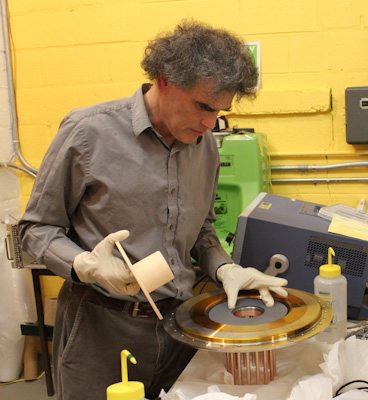New Jersey nuclear fusion firm ratchets up Iranian collaboration


Lawrenceville Plasma Physics, the U.S. company that is campaigning for peaceful and limitless energy via cooperation with Iran in developing nuclear fusion, has taken a bold step forward in that pursuit.
The small Middlesex, N.J. firm entered an agreement with Tehran’s Islamic Azad University to jointly design a fusion machine that is “high current and high energy” and that “would be affordable to construct in industrializing nations,” according to a contract I saw late last week, when I broke the story in The Guardian.
Eric Lerner, LPP’s president, and Mahmood Ghorannevis, who is head of Azad’s Plasma Physics Research Center (PPRC), signed the papers over the weekend of May 19th.
Some experts have for decades regarded fusion as the Holy Grail of energy sources that does not produce the dangerous waste associated with today’s fission nuclear power, and that augers a limitless supply of energy. Fusion puts atoms together rather than splitting them apart.
The problem so far has been that the elusive fusion process requires more energy than it returns.
To get around that obstacle, LPP is working on a form of fusion that’s different from “standard” fusion. It’s called “aneutronic”, and it does not rely on hot neutrons that escape during fusion and provide heat that drives a turbine.
Instead, it generates electricity directly – cutting out the turbine – by creating charged ions. LPP says aneutronic costs much less than neutron-reliant fusion, in part because an aneutronic machine can be much smaller.
Aneutronic fusion relies on an area of physics known as “plasma physics.”
“Iran is the only country at present, other than the U.S., which has a substantial research program in aneutronic fusion,” the press release states.
“Iran’s controlled fusion program has focused on these economical aneutronic devices in an attempt to leapfrog over (conventional) fusion to get a cheap, clean and inexhaustible energy source.
“Already, Iran has set up more active DPF (dense plasma focus) research groups – six – than any other country in the word. The United States is the only other country with an active aneutronic fusion effort.”
Geopolitical critics say the collaboration will never pass muster with U.S. trade sanctions, in place amid allegations that Iran is enriching uranium - the fuel associated with conventional nuclear fission – to make nuclear weapons.
But Lerner claims the accordis exempt under a U.S. Department of Treasury stipulation that “authorizes collaborating with academics and research institutions on the…creation and enhancement of written publications.”
LPP notified President Obama’s Council of Advisors on Science and Technology of the partnership last Friday.
The agreement with Azad follows an LPP breakthrough last March, in which the company confined a gas for nanoseconds at 1.8 billion degrees C, much hotter than an industry record of 1.1 billiion degrees C that had stood since 1978.
LPP said in its press release that Azad’s Ghorannevis proposed the collaboration after learning of LPP’s “Fusion for Peace” petition aimed at forging fusion research ties between the U.S. and Iran. The phrase draws on the old "Atoms for Peace" slogan.
U.S. startup Tri-Alpha Energy, Irvine, Calif., is also working on aneutronic fusion.
Other fusion startups include General Fusion, Burnaby, Canada, and Helion Energy, Redmond, Wash. Both are working on neutron-based fusion and say their approach is less expensive than the giant €13 billion ($16.2 billion) international, government funded ITER fusion project in Cadarache, France.
Photo from LPP.
More fusion and alternative nuclear on SmartPlanet
- Joint U.S., Iranian nuclear peace plan hatches
- Fusion breakthrough
- Safe nuclear: UK eyes thorium
- Safe nuclear: Let the thorium debate begin
- Safe nuclear: India’s thorium reactor
- Joint U.S., Iranian nuclear peace plan hatches
- Fukushima’s lesson: ‘Alternative’ nuclear, not ‘no’ nuclear
- Watch replay of nuclear’s future, with dash of rare earth
- Why safe nuclear will rely on rare earth minerals
- Meet the future of nuclear power: 8 guys in China
- The new face of safe nuclear
This post was originally published on Smartplanet.com